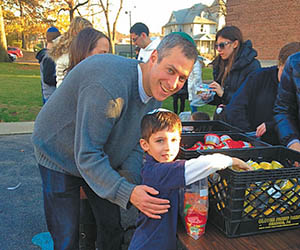

Kehillat Kesher, the Community Synagogue of Englewood and Tenafly, was founded in 2000, when eight families from Manhattan’s Upper West Side boldly decided to start a new community in New Jersey. Evan Sohn, one of the founding members and a past president of the shul, explained: “The founding families all grew up in small towns that eventually became larger Jewish communities. We wanted to start a new community that would enable our children to have a similar small-community feel that we grew up in,” he said.
The shul is located on the border of Englewood and Tenafly, and the surrounding community encompasses a radius of about a mile. This area was selected by Estie Agus, the first president of Kesher. According to Sohn, she “looked at a number of areas in New Jersey and felt that this area, on the outskirts of Englewood and Tenafly, would enable us to build a new community and still have access to all the Jewish services of the neighboring area.”
The small-town feel and warmth of the Kesher community has led to its incredible growth, from just eight families in 2000, to 165 in 2015. Rabbi Akiva Block, Kesher’s rabbi since 2010, noted that when he first visited, he was struck by the “warmth, cohesiveness and camaraderie in this community.” That is a sentiment echoed by many families who choose to move to Kesher, after visiting for a Shabbat.
Rebecca Tenzer, who joined the Kesher community with her husband and twin sons in 2013, was attracted to the neighborhood because “we heard great things about the community and decided to visit for a Shabbat. We felt the positive energy right away and knew it was a good fit for us. It felt warm, diverse and lively.”
Guests and visitors always receive a warm welcome. A hallmark of the shul, according to Sohn, has always been that “on a typical Shabbos the kibbudim such as aliyot go to visitors and guests. We dance not only for children being born from our own members but for children of guests visiting during their stay at [the nearby] Englewood Hospital.” Rebecca Tobin, the current president of Kesher, emphasizes that “all new faces receive introductions, welcomes and lunch invitations.”
Tobin highlights a variety of reasons why so many families are attracted to the Kesher community. Some, she says “join specifically because of our focus on warmth, chesed, davening and learning. Others join because of the friendliness of our members. We also have a lot of adult siblings who followed one another to Kesher, my family included.”
Once ensconced in the community, members reap many benefits. Tenzer points out a unique attribute; that children at Kesher have friends from many different schools. She is impressed by “how many elementary schools are represented in the community, yet it remains so cohesive.” This is in contrast to her childhood, “spending most Shabbat afternoons with friends from my school. [At Kesher], kids get to enjoy the best of both worlds and really branch out.”
Community members, according to Tobin, “take care of each other when babies are born, when, unfortunately, loved ones pass away, and when people are sick or need help. It is a great blessing to be part of such an active and dedicated community.”
As the community expands, so does the challenge of maintaining the small-town feel that the founding members envisioned 15 years ago. Rabbi Block notes that “our community has grown tremendously over these last few years. While that same warmth and togetherness are certainly still apparent, they have become a greater challenge to maintain.” Tobin adds that “we are at the point at which not everyone knows each other. Yet we still think of ourselves as a small, intimate shul and want to continue to do so. The challenge is to maintain that closeness even as we grow in numbers.”
This challenge will be much easier to tackle, now that the community has moved into a brand-new shul, after starting construction in 2013. In 2005, after the initial eight families outgrew davening in one family’s basement, the community purchased and began davening in a small Victorian house. At the time, they “knew it would last 7 years,” according to Sohn, after which the house could no longer accommodate the membership as increasing numbers of families joined Kesher.
While the new shul was under construction, the community took on a nomadic existence. Tobin lists the various locations that housed the community: “Members opened their homes to host minyanim on Friday nights, Shabbat afternoons or for shul meetings. We rented or borrowed space from local institutions including the D.A. Quarles Early Childhood Center, Temple Sinai of Bergen County, Englewood Hospital and Medical Center, The Moriah School and East Hill Synagogue.” She adds that “we are very grateful for the hospitality of these five institutions, which have accommodated us on Shabbat and holidays.”
The Kesher community began davening in their beautiful, new shul on January 15, 2016. The excitement was palpable, with members wishing each other mazel tov, participating in an especially uplifting davening, and lingering over a hot kiddush in the social hall.
The new shul, according to Rabbi Block, will “expand opportunities for our members to get involved and stay involved, whether it be through more minyanim, expanded adult education offerings, or increased involvement in communal matters. With our new, beautiful building, I think we’re all looking forward to the opportunity to grow Kesher into an even greater place than it already is.”
For more information about Kehillat Kesher, please visit www.keshernj.com.
By Robin Tare












